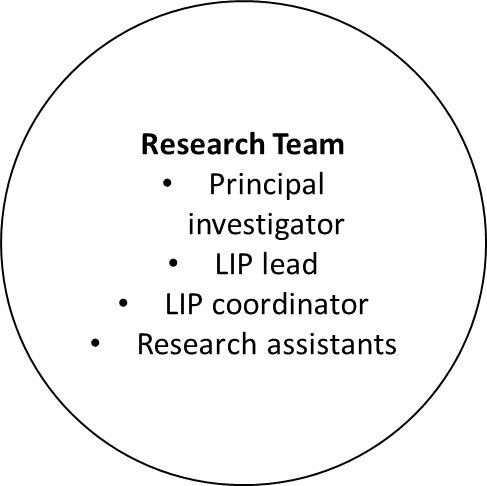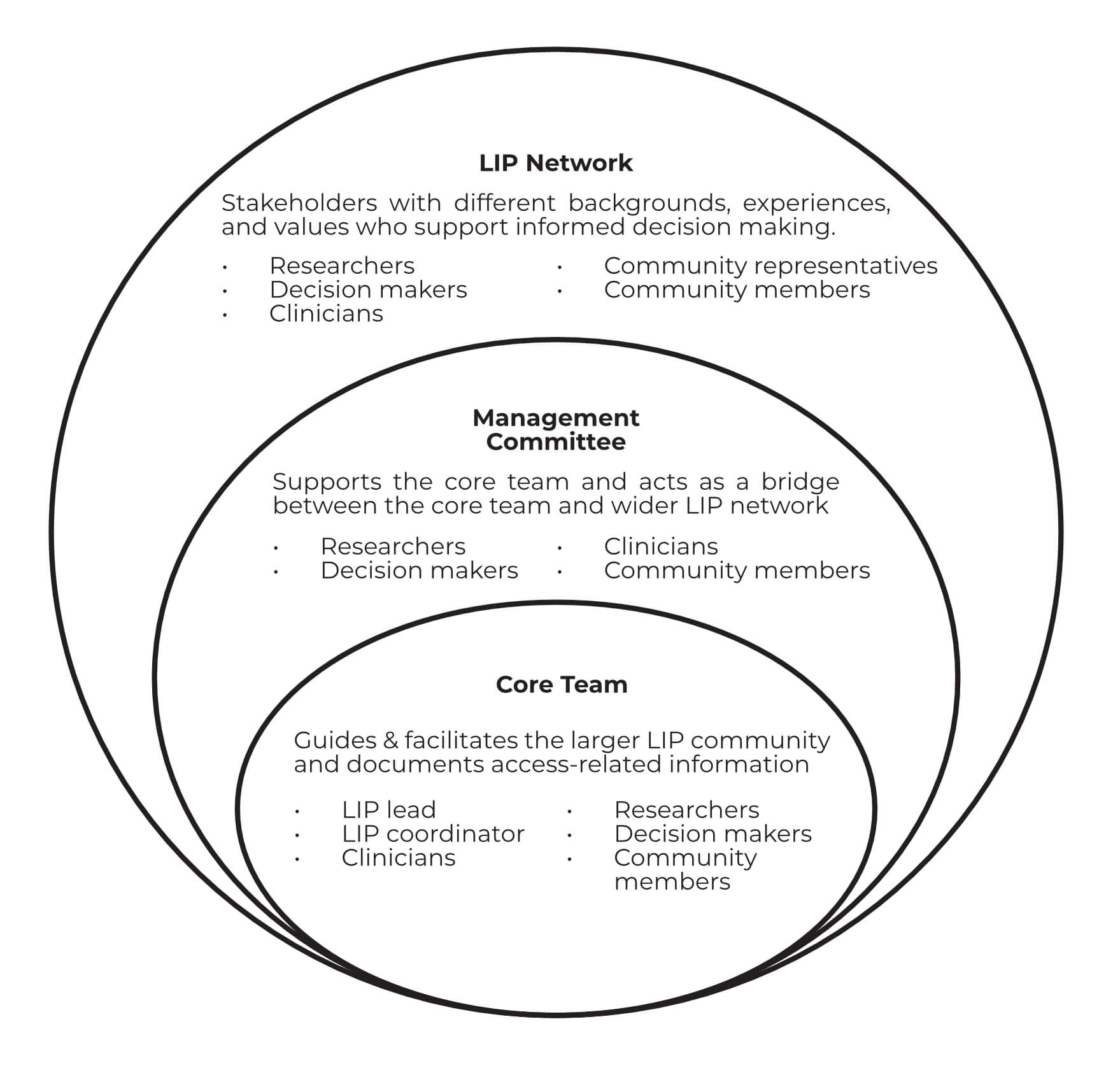Governance
Each LIP consists of a small governance team (LIP Core Team) comprising the lead researcher, a LIP Lead, LIP coordinator, decision makers, researchers, clinicians, and members of the vulnerable communities. In some contexts, the need for a LIP Management Committee may be identified. Depending on their composition, some LIPs may require a governance document (in many contexts, this will be a Charter; see Appendix B) that outlines the purpose, governance, principles, key stakeholders, roles, and responsibilities for the LIP and serves as a reference of authority for the future of the LIP. The LIP Core Team may also be required to develop a Memorandum of Understanding (MOU) (see Appendix C) that includes signatures of key stakeholders, including relevant community organisation(s).
LIP Core Team
The LIP Core Team is comprised of 5–8 members, including the LIP Lead and LIP coordinator, and can include:
- researchers;
- decision makers;
- clinicians; and
- community members.
It may be tempting to add more members to address issues of representation; but, a committee that is any larger or smaller tends not to be efficient and effective (Hackman, 2002). The LIP Core Team does not need to be representative of all of the key stakeholders, but does need to be effective. The LIP Core Team should meet regularly to ensure that there is adequate dialogue to achieve the goals and to review LIP progress.
LIP Core Team members are involved in the following core activities:
- Ensure appropriate team composition and LIP engagement:
- ensure adequate representation of decision makers, researchers, clinicians, and members of the vulnerable communities in the LIP Core Team;
- if required, establish a LIP Management Committee;
- connect to the larger LIP community, including engaging local champions around access to comprehensive CBPHC for vulnerable populations;
- guide and facilitate interaction with stakeholders in the geographic area, with the long term goal of developing a wider regional network.
- Document access-related needs, context, assets, and existing organisational innovations:
- guide collation and interpretation of relevant data;
- identify access-related primary health care interventions in the region;
- identify priorities for addressing access-related issues through stakeholder consultation and (likely) deliberative processes.
- Inform and support research and evaluation by:
- advising on the selection of identified organisational innovations for more in depth review;
- assisting in the interpretation and contextualization of findings of reviews;
- selecting the organisational innovation to be evaluated in the region;
- supporting the mobilisation of resources to assist in the implementation;
- providing feedback on knowledge mobilisation strategies, stakeholder engagement, decision making (i.e., what is working in the local context and areas for improvement);
- ensuring that comprehensive documentation is maintained in accordance with a developmental approach to evaluation (e.g., how decisions made through deliberative processes are used to inform research, policy, and practice (see Gamble 2008).
The LIP Management Committee
Where a LIP Management Committee is identified as necessary to bridge the gap between the Core Team and the LIP Networks, it may consist of up to 15 members, some of whom may be LIP Core Team members. If a Management Committee is not part of the LIP structure, the duties outlined below should be incorporated into those of the Core Team.
Members may include:
- researchers;
- decision makers;
- clinicians; and
- community members.
The LIP Management Committee will have the capacity to facilitate mobilisation of resources to support LIP activities, including implementation of the organisational innovations. The LIP Management Committee can meet regularly or on an ad hoc basis as determined by the LIP Core Team. In some jurisdictions, the functions of the LIP Management Committee may be incorporated into those of a pre-existing committee or structure.
LIP Management Committee members are involved in the following activities:
- supporting the LIP Core team in its operations and achieving its goals;
- facilitating access to relevant regional CBPHC data;
- giving advice on the collation and interpretation of relevant regional primary health care performance data;
- identifying access-related primary health care interventions in the region;
- assisting in the identification of participants in the deliberative processes;
- providing specific input to LIP decision-making at key points, depending on their role within the LIP community and/or their area of expertise.
The IMPACT Reality
| In practice, the composition of IMPACT’s six LIPs varied significantly. The research-driven nature of the IMPACT program meant that the research team, composed of the principal investigator and research assistants, along with a LIP lead (in some cases) and LIP coordinator, performed many of the functions of the Core and Management Teams. For most LIPs, the inclusion of community members in the Core Team was not feasible, leading some LIPs to recruit community representatives to fill this role. Finally, in most cases, the LIP network took time to develop and was not always a structured entity. |  |
community-based primary healthcare
a novel set of behaviours or routines implemented through planned and coordinated actions (based on Greenhalgh, 2004)
Excludes innovation aimed at individual practitioner behaviour changes (e.g., clinical practice, treatment innovation) if they are not intended to address one of the dimensions of service accessibility
Excludes innovations aimed at community members (e.g., general health literacy strategies)
Requires action to be planned and coordinated
May include behaviours or routines provided off-site or externally that improves accessibility of the community-based primary health care organisation (e.g., routine access to telephone translation services).

